The World Cup 2022 in Qatar will be the 12th time that Switzerland appear in the tournament, having made their first appearance in 1934. Despite missing out on the tournament in 1998 and 2002, they returned in 2006 to progress all the way into the knockout stages. In the last two World Cups in Brazil and Russia, respectively, Switzerland reached the round of 16 both times.
Murat Yakin will be hoping that his men make it to the knockout stages for a third consecutive time. Though they will have a lot of work to do in order to advance to the next stages. They have a competitive group that consists of African giants Cameroon, Serbia and big favourite Brazil. With a decent squad at their disposal, Switzerland will be hoping to exceed expectations in this tournament. In this tactical analysis, in the form of a scout report, we will be discussing Switzerland’s tactics and playing style. Let’s begin the analysis.
Predicted starting XI
The graph below contains a breakdown of the probable pool of players that Switzerland’s 26-men squad may be comprised of, along with their age and the number of minutes that they have played in the past year. The interesting thing to be inferred is that there are quite a few youngsters (less than 24 years) and just two players over the age of 30 and beyond their peak. Among those in the peak years, we see that the players are mostly clustered in two extremes. We see a lot of players have completed their 24th year or 29th year with few of them in between.
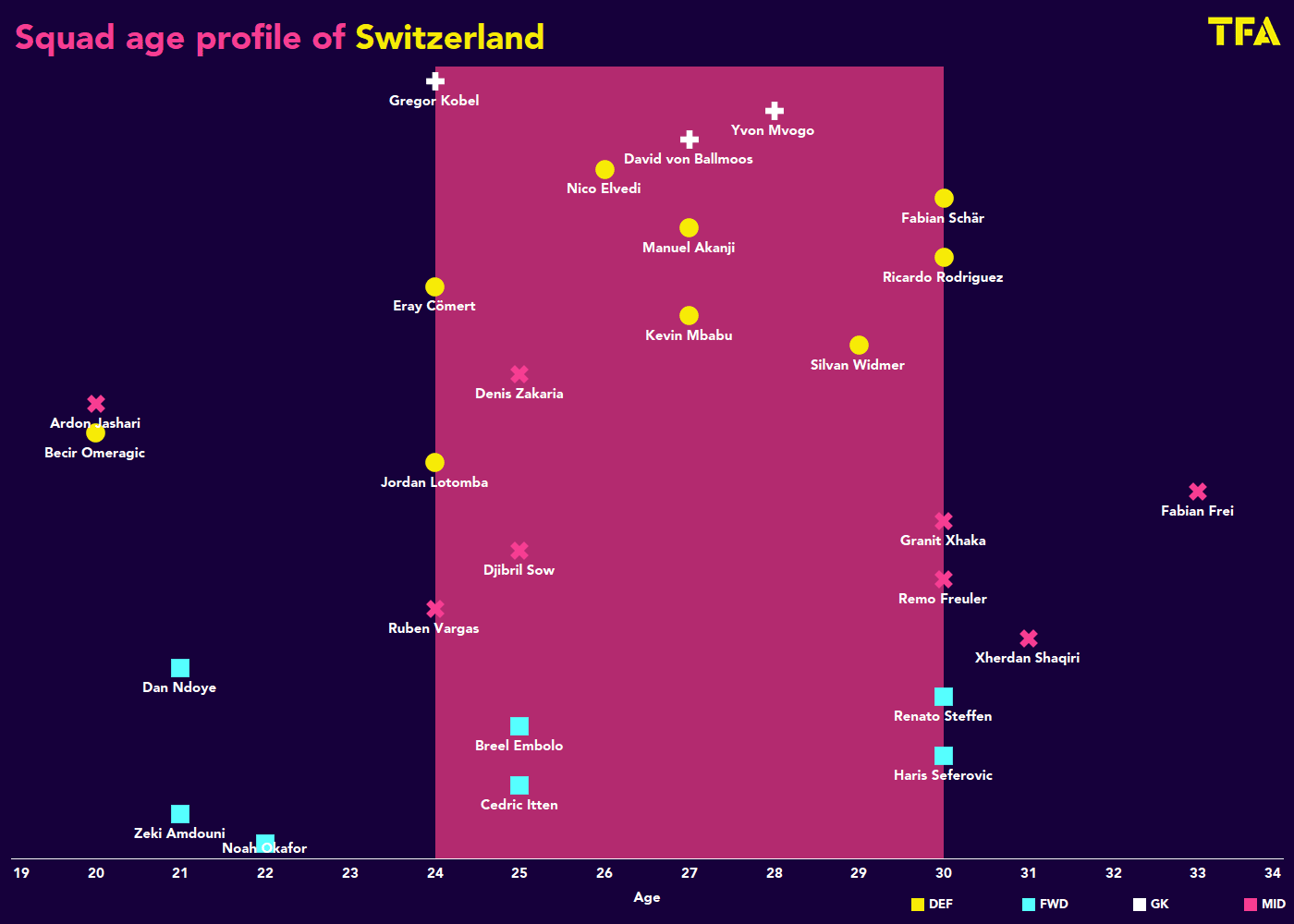
This means that their squad is quite balanced in terms of age, and it looks as though they’ll feature mostly players in their peak years. There are a couple of obvious choices from each department. After Yann Sommer’s injury in the Bundesliga, it remains unclear whether or not he’ll be ready for the tournament. Therefore, Dortmund’s Gregor Kobel is likely to be their number one.
In front of him, the obvious defenders would be Ricardo Rodriguez and Manuel Akanji while the likes of Kevin Mbabu, Silvan Widmer, Nico Elvedi and Fabian Schär are also expected to make it into the final squad.
Among the midfielders, Granit Xhaka is going to be their main man in the middle of the park, while the likes of Freuler and Djibril Sow will be partnering him. The other options could be Denis Zakaria who is also expected to make the squad. The attacking department will be spearheaded by Breel Embolo while other viable options include Haris Seferovic, Ruben Vargas and Noah Okafor.
Based on the players and Yakin’s recent lineups from friendlies and UEFA Nations League matches, the probable starting XI will be similar to the one in the image below.

Attacking Phase
The attacking metrics tell us that Switzerland are not a very dominant team when it comes to playing with possession. Their percentile rank of 15 for possession means that they average very little possession per game when compared to the other teams at the World Cup. They also rank below the median level for the number of shots taken per match and provide lots of shots from the distance. Because of this, they create very few high-quality chances as their xG per match is in the ninth percentile — way less than the average team playing at the World Cup.
Switzerland tend to use the long ball very often, as seen in the chart. At the same time, they don’t play many progressive passes. Even when they play long balls they don’t look to play it quickly due to their conservative approach. This has often led to teams immediately reorganizing into a low block against them and they have often struggled to get into the penalty area as seen by their relatively low number of touches averaged in it.
Most of their chances come from crosses as they tend to use crosses more with the likes of Rodriguez and Widmer being very good crossers of the ball. They also lose too many offensive duels as they have a percentile rank of 6.
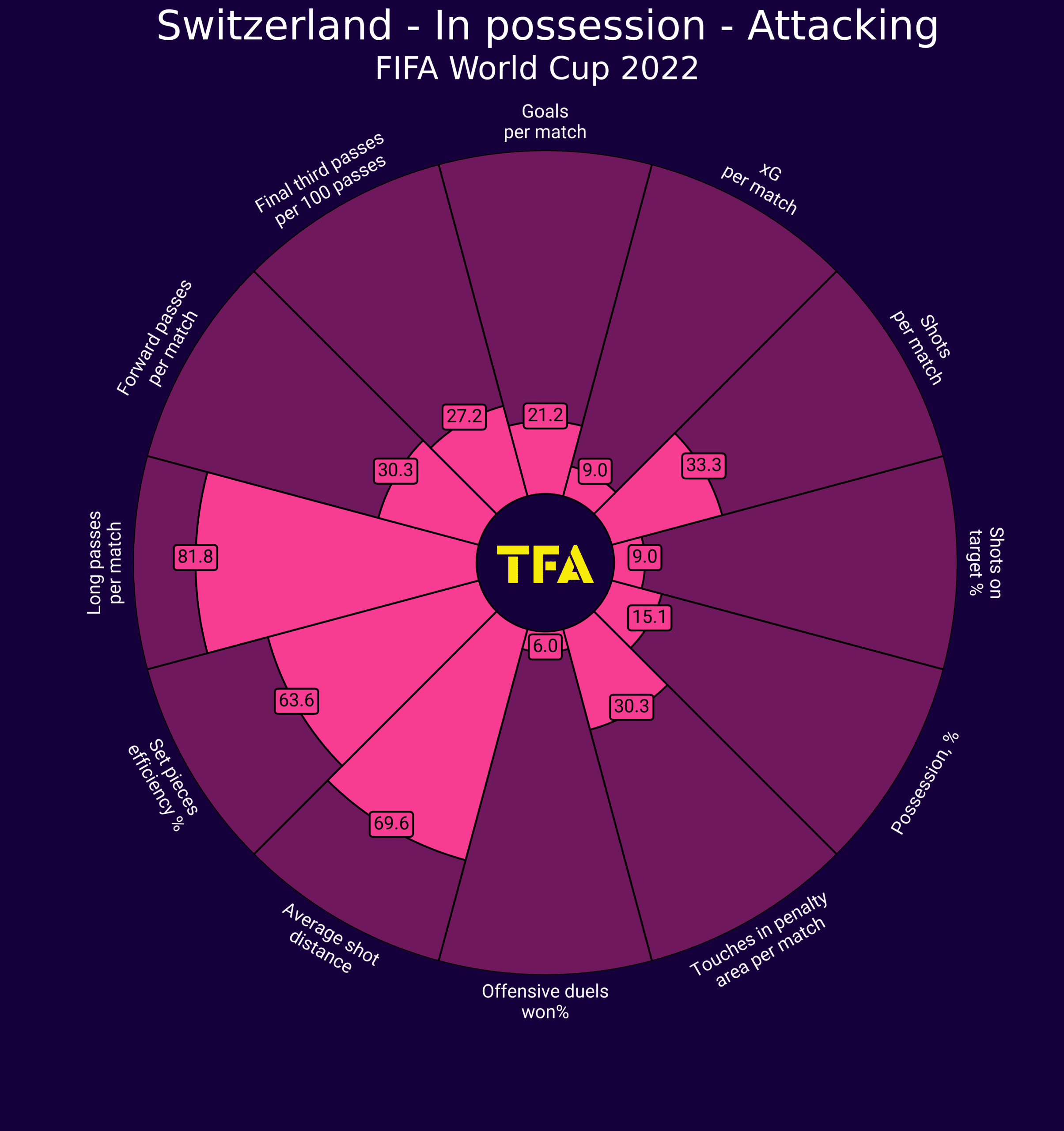
In most situations, Switzerland look to play the ball out from the back by inviting the opposition to press. With two centre-backs, they would look to split their centre-backs wide and their goalkeeper would help the backline by forming a +1 option against the opposition’s press. This would result in a five-man backline (including the keeper) as the full-backs would now play higher and create a 2v1 against a player like in the image below.
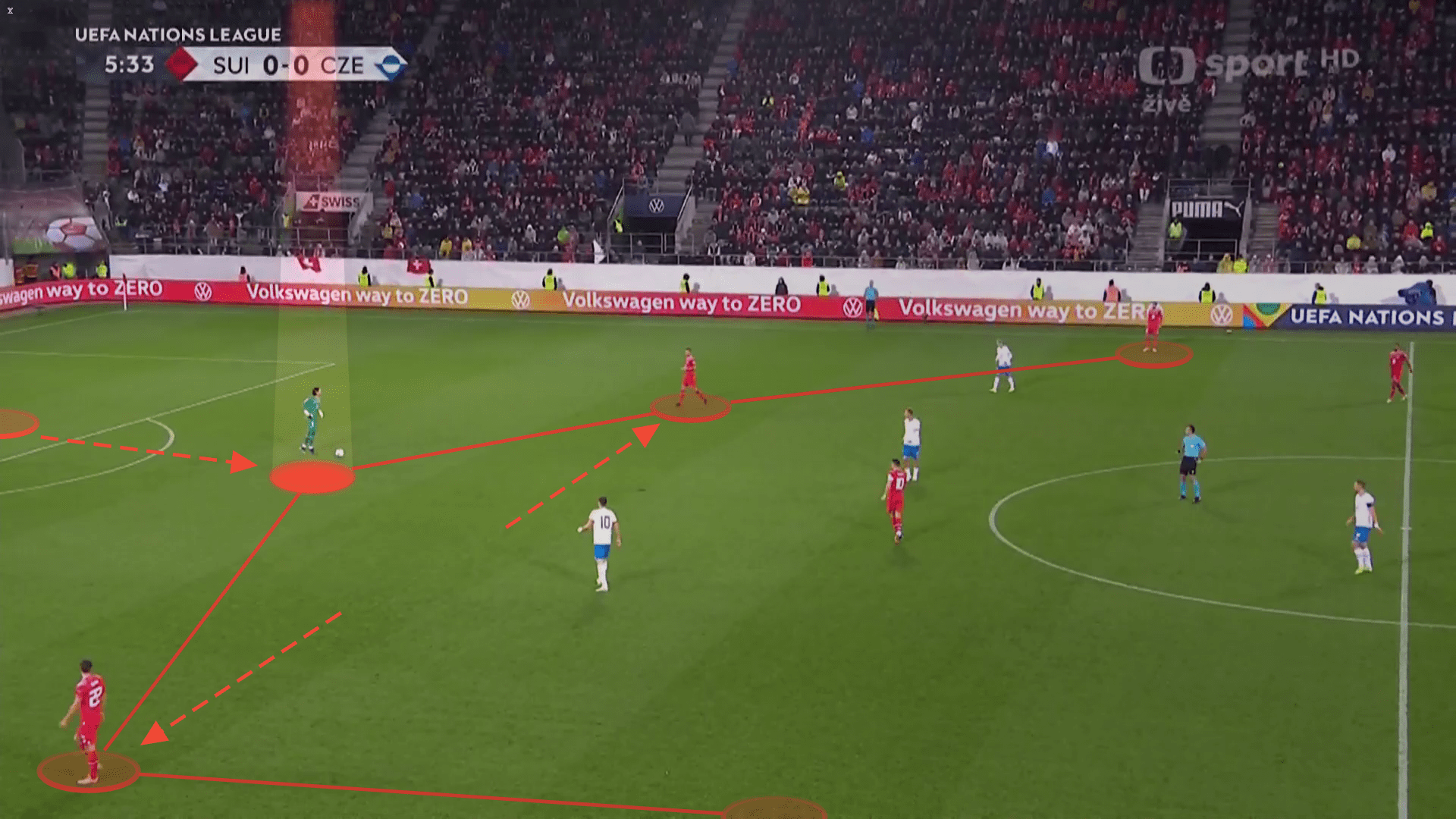
Their shape in the final third is typically a 4-1-4-1, with Xhaka staying deeper in case of defensive transitions and Freuler pushing forward next to Djibril Sow in attacking midfield. This helps to stretch the defence horizontally.
Xhaka’s importance to the team is huge; during their attacking phase, his positioning and ability to find players in space is crucial for Switzerland to move into the final third. We already saw from the chart before that they are very conservative on the ball. So Xhaka’s ability to progress the ball for them is very important to their attack.
We can see him dropping as a centre-back in lots of situations. This means that the player marking him has to commit forward leaving space behind him. This can be used by another player to drop into that space. Having one player stretching the defence vertically, the other can use the space effectively.
Also, as a whole, the positioning of the central midfielders is crucial if the opposition looks to man-mark them. Switzerland usually does this to manipulate the opposition by dragging them out of their position. This opens a passing lane for one of the forwards to drop into and receive the ball as they do in the image below.

The likes of Shaqiri can benefit from these sequences as he can drop into these central regions and drive forward. If the opposition’s centre-back decides to follow him, he can use his trickery to get past, and Switzerland will then have an overload with two other forwards already ahead.
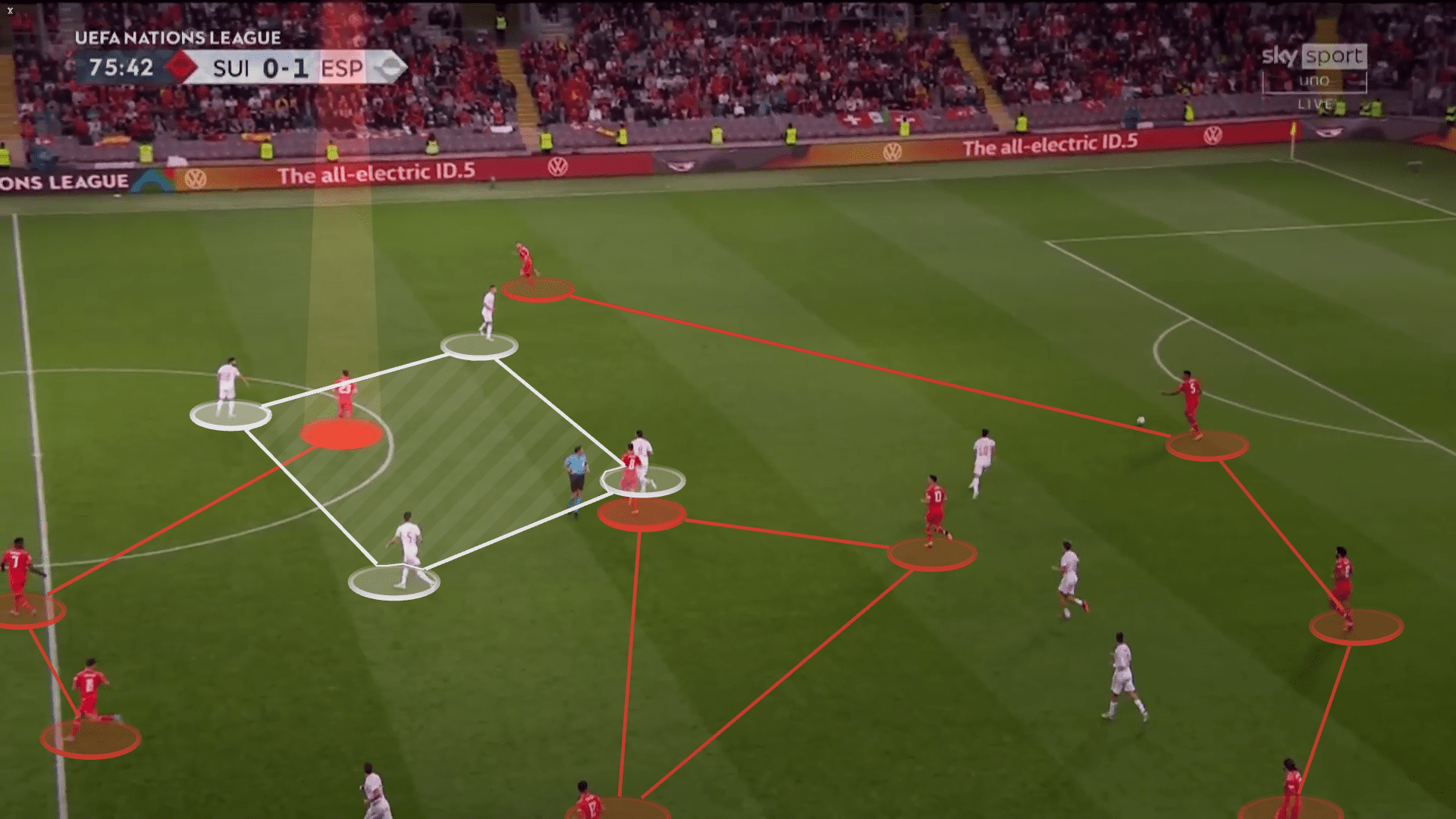
Overall, the underlying metrics say that Switzerland, despite possessing some high-quality forwards and midfielders, have performed below average. If they want to progress past the group stage against Brazil, Serbia and Cameroon, they need to get their attack firing at their best. Their ability to get the most out of the likes of Embolo and Ruben Vargas will be crucial to their attack succeeding on the big stage.
Defensive Phase
Looking into their defensive statistics over the last calendar year, we see that Switzerland are less intense when compared to the other teams present in the tournament. They have a very high value for PPDA, which is the number of passes they have allowed for every defensive action they make, which describes their less intense approach during defensive phases.
However, being a passive team in terms of their pressing has directly impacted the number of recoveries they make per game. They have an average ranking in recoveries but a very high ranking in recoveries in their own half, showing their defensive approach.
Switzerland don’t contest a lot of duels per game, as this includes not only pressing and tackling but also other ground duels when they man-mark an opponent. Also to be noted here is that they have a very low success rate of winning these duels as their success rate is less than 97% of all other teams competing at the World Cup.
Their interception stats are very decent and are very much at the top level. This kind of explains their defensive style as they look to get their positioning right and stay in the right position to intercept the ball. This means that mostly when an opponent looks to attack them, they do not tend to commit very much and would often look to delay the process as much as possible and win the ball back by blocking passing lanes.
Their reactive approach means that they have often allowed a lot of shots from their opposition as seen from the chart. Despite that, they have conceded fewer goals overall as they block the shots very well and Yann Sommer has done a good job of preventing goals.
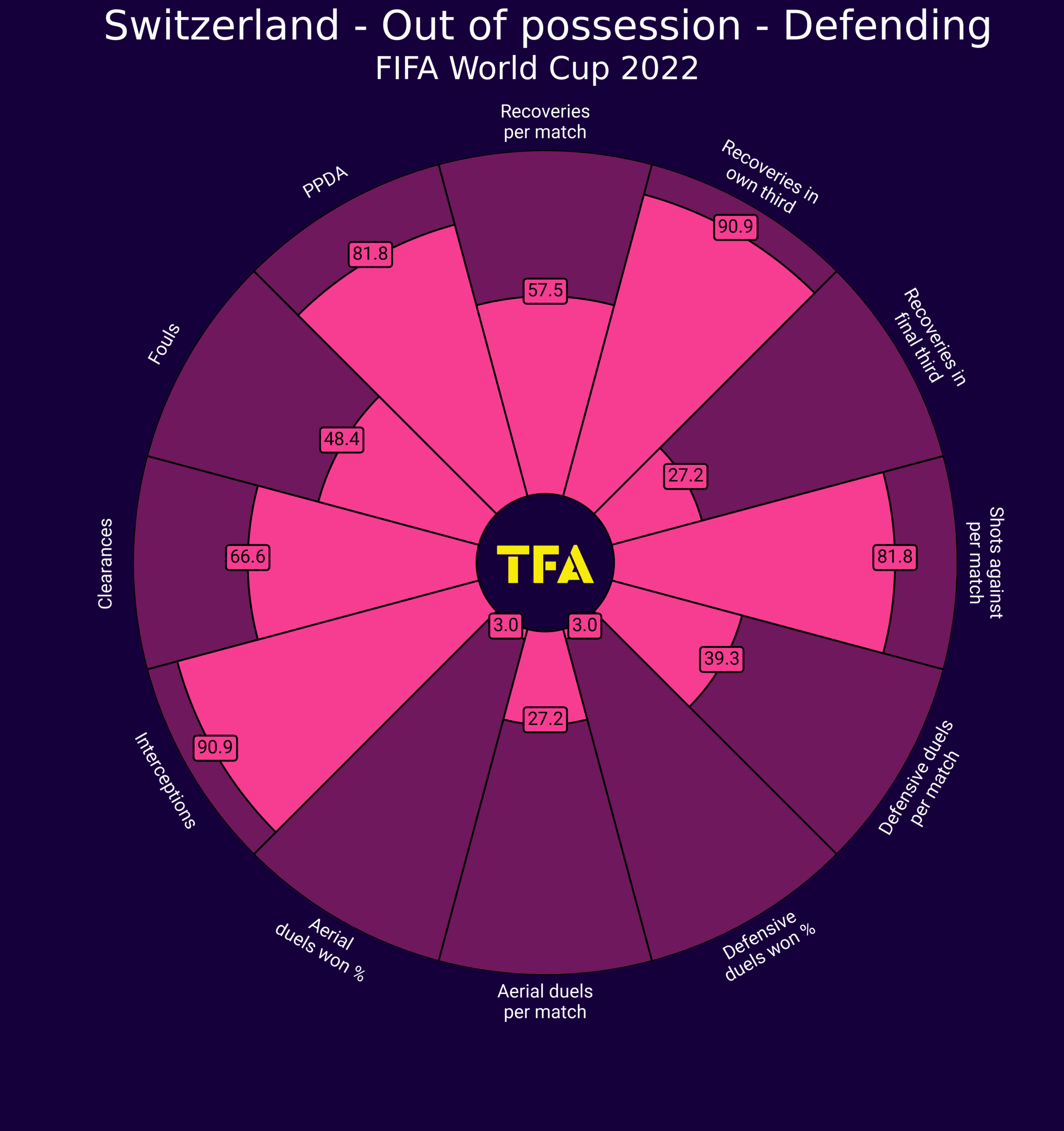
Switzerland look to deploy a ball-oriented pressing structure where they look to overload the ball side in most instances and try to force a turnover. Their idea behind the setup is to squeeze the space around the ball and block nearby passing lanes.
The issue with this form of pressing is that it leaves a lot of space for the opposition on the far side and a single switch by a player to that side would cause a lot of issues. An example of that is given below where Switzerland have a lot of players committed to the ball side but have left huge space in front of the defence as they have left it underloaded. We can see an example of that in the image below.
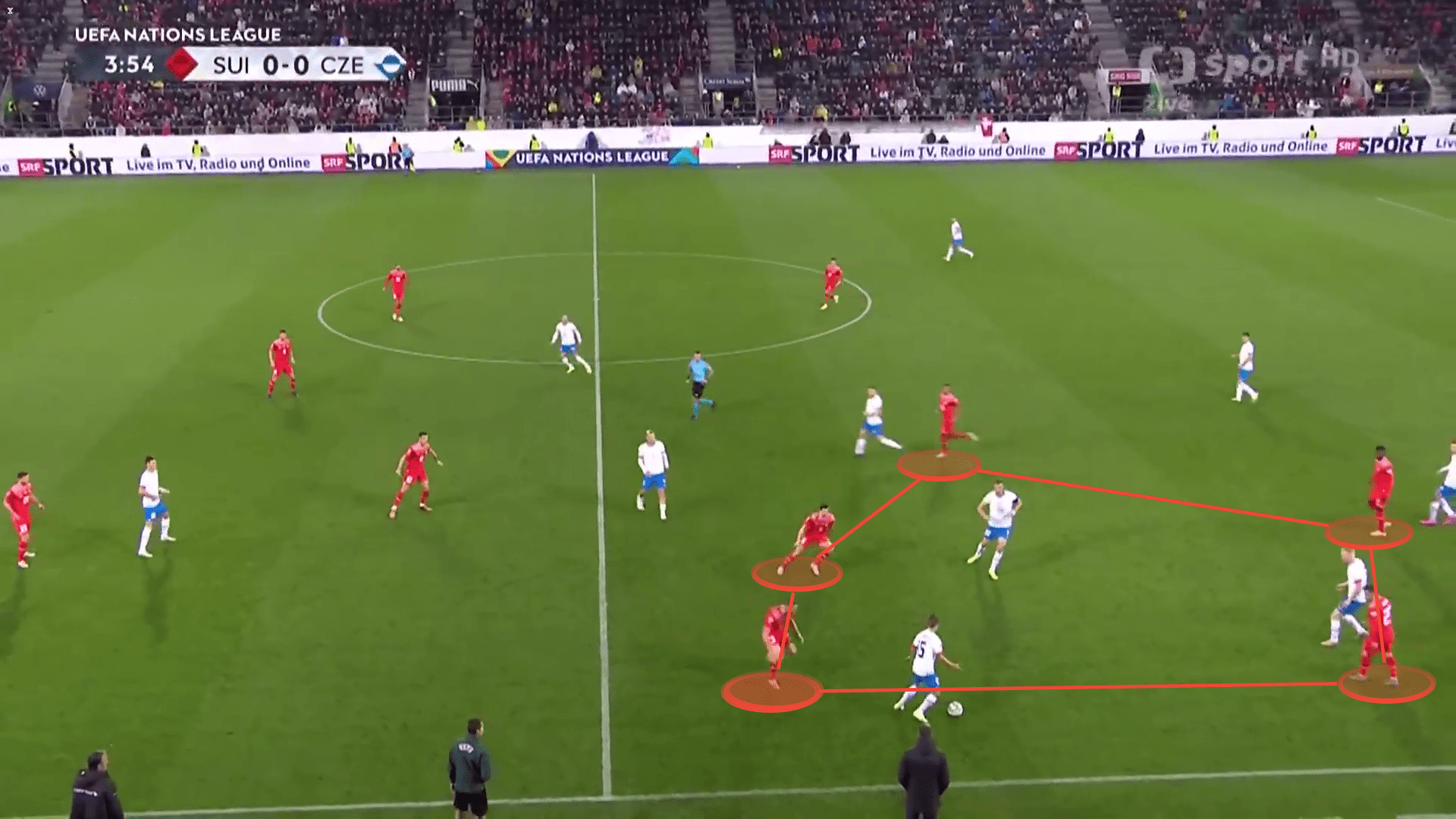
In their low block, they maintain a 4-4-2 system which is not that unusual as several teams that use 4-2-3-1 tend to use a 4-4-2 as their preferred low-block setup. They can transition into this shape quickly from the 4-2-3-1 and this shape also ensures quick counter-attacks are always a possibility.
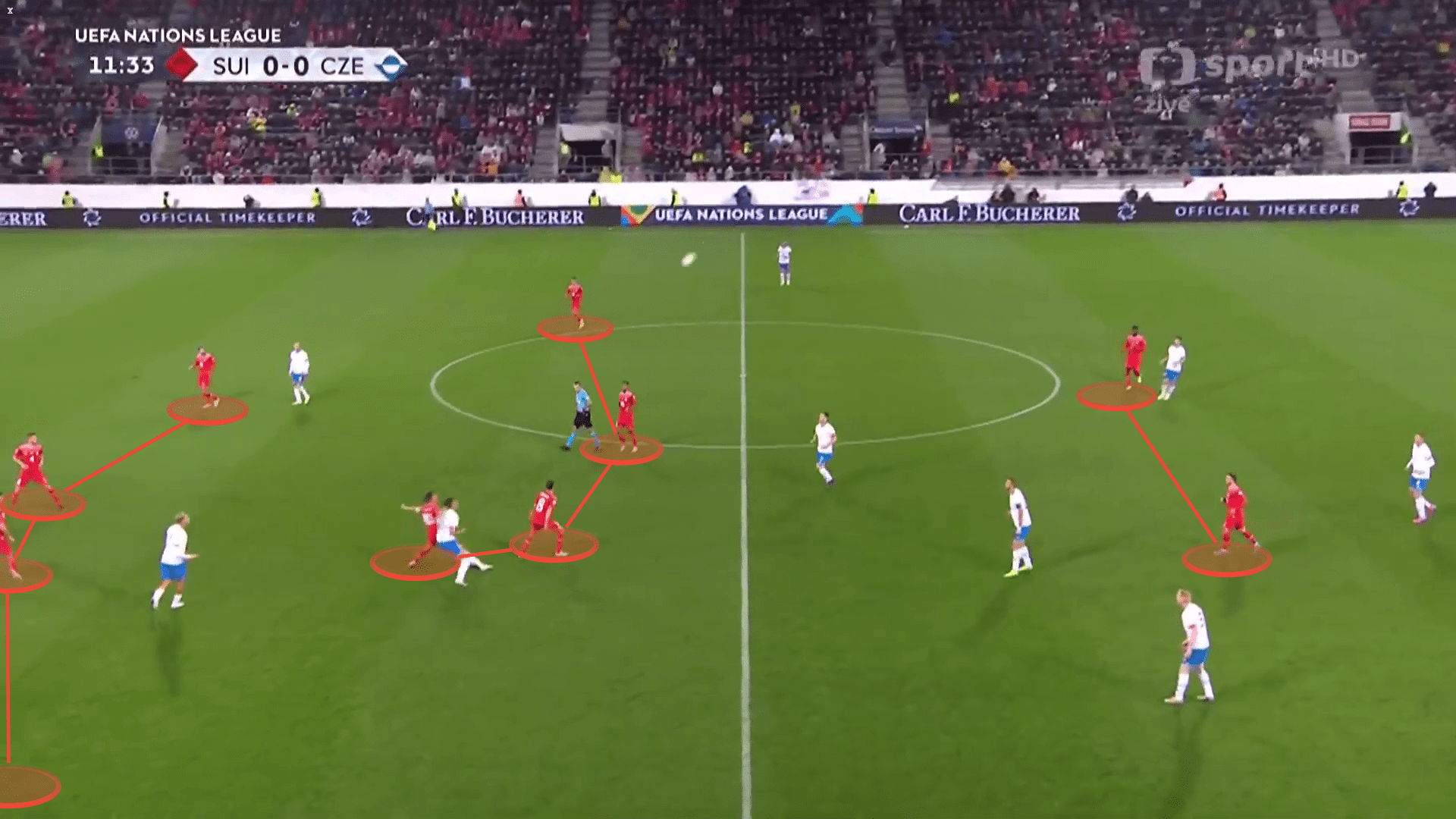
Overall, Switzerland are a very good team on the defensive front. They have some outstanding players like Akanji, Xhaka and Rodriguez who form the defensive backbone of the team and provide the team with the solidarity they need.
Akanji will also play a key role if Gregor Kobel will be the number one as he hasn’t played much for the national team yet but knows Akanji’s style of play very well from his time at Borussia Dortmund. Though systematically they have some deficiencies, their individual players are capable of masking that and pushing the team forward.
Transitions
We mentioned that they like to defend by delaying the attackers and mostly look to find the right situations to make recoveries and intercept the ball instead of diving into challenges. They use a similar set of principles even during transitions.
The reason why this would be effective is that it could effectively give them the time to have their players, who went forward, track back and form an overload. And also, against fast and skilful attackers, this method would ensure that the options for them are blocked while also not providing them with the space to go forward.
An example of this can be seen below where the Swiss players are tracking backwards while having the right body orientation so that Spain’s attackers don’t have the right options to pass or make runs into.
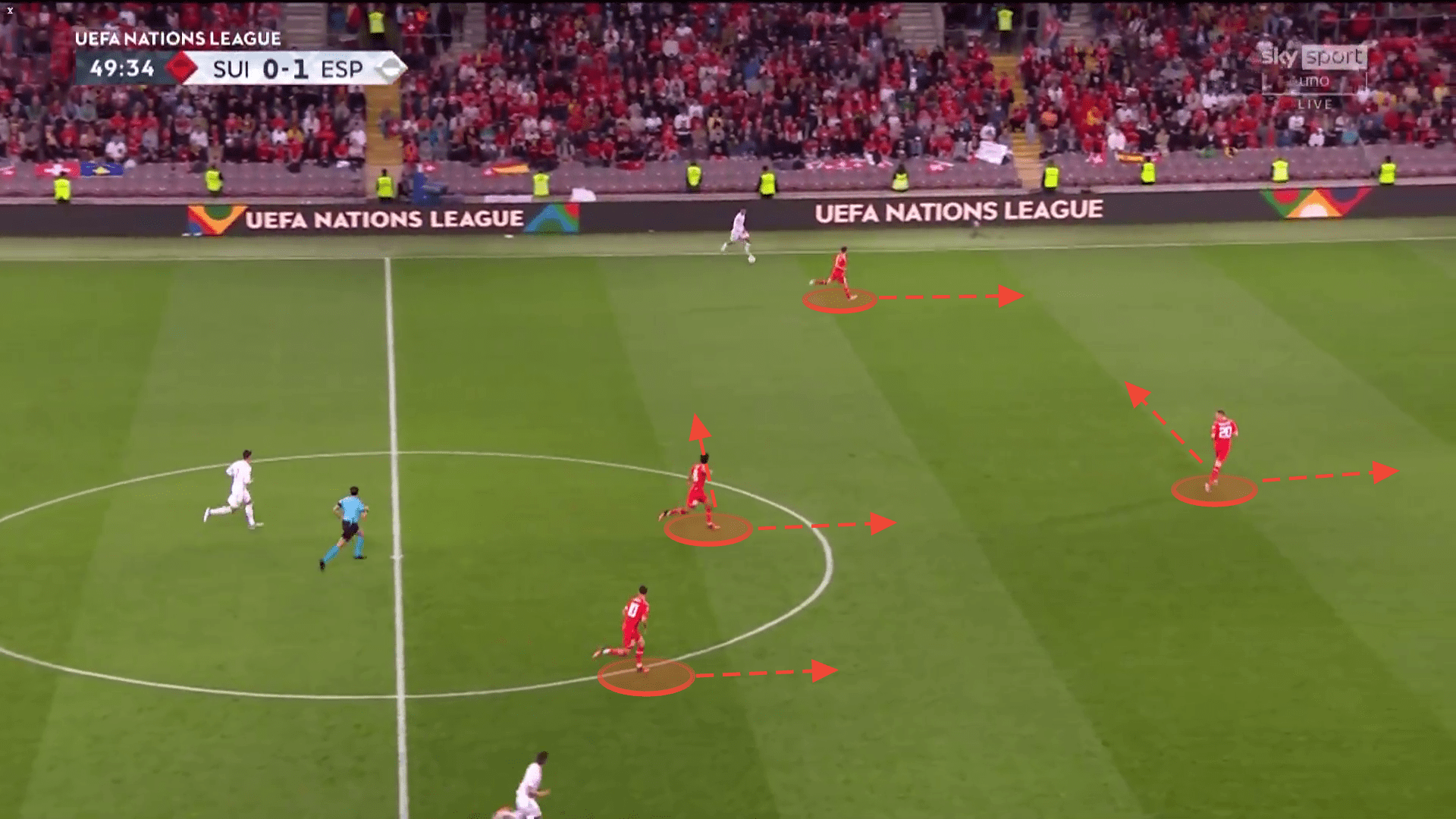
During an offensive transition, Switzerland generally look to commit just their three forward players to the counter-attack. By doing this, all three players are moving towards the centre instead of the wingers staying wide. With the likes of Embolo, Vargas and Okafor, Switzerland has several offensive players providing very good acceleration and high speed. An example of this can be seen in the image below.
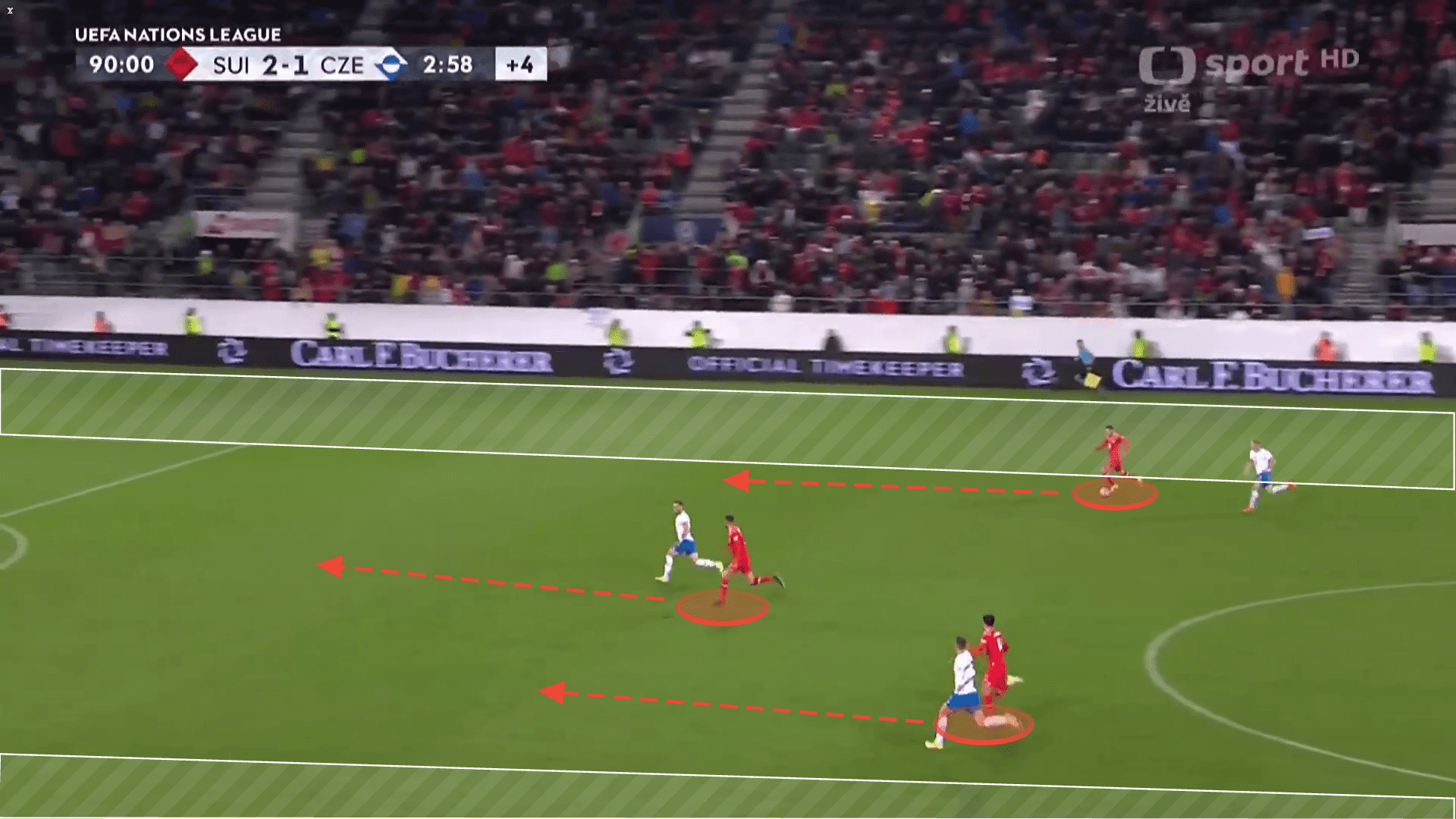
With the pace and power from the likes of Embolo, Okafor and Vargas along with Xhaka and Sow providing creativity for them, Switzerland look to be a very threatening team on the break. Most of their counter-attacks have been stalled or unsuccessful due to decision-making in the final third. If they can sort that out, then it would be hard to stop them in these situations.
Attackers
Comparing potential Switzerland forwards, Cedric Itten has averaged the most number of touches inside the box among the Swiss forwards. The Young Boys’ forward has also taken the second-most number of shots per game behind Seferovic. The latter records a high amount of touches inside the box too and is therefore only behind Itten.
Looking into the Embolo, whom we predicted would be a starter, he seems to be around the median mark for both touches as well as shots. This is obviously impacted by the league in which he plays, as Ligue 1 is relatively more competitive than the leagues in which the other Swiss forwards compete. Vargas is much less involved in taking shots and moving into the box, which is expected given that he is a winger.
Comparing their goal contributions, Seferovic seems to overperform his expected contributions by proving to be clinical. Itten seems to be amassing better-expected goal contributions than Seferovic while not being as clinical as the latter. Despite that, he performs better than most of the other forwards and looks likely to book his ticket to the main tournament.
The likes of Embolo and Vargas seem to be behind the other players even when it comes to goal contributions, of course for the obvious aforementioned reasons. Despite that, Embolo will be the main attacker starting for Switzerland. This is due to his experience playing in a top-five league and also being quite young means that his pace and energy could be used effectively in correspondence with Seferovic’s experience.
Overall, Switzerland have a decent attack with some exciting young talents and a couple of experienced campaigners. The only concern is that they do not have forwards in their definite peak period with all those mentioned options either entering their peak or just leaving it.
Midfielders
Among the midfielders, it is clear that Arsenal’s Granit Xhaka is their key progressor of the ball and is probably one of the best in the business in that area. We will discuss his ability and importance to the team in detail later but for now, it’s clear that Xhaka is key to Switzerland’s ability to progress the ball from their defensive third to the final third.
Closely following him behind is Remo Freuler who has also seemed to be a good progressor for his club, Nottingham Forest. The two midfielders in our predicted lineup were Freuler and Xhaka. The reason for that is both are quite progressive on the ball while also complementing each other defensively. While Xhaka approaches in a much more composed manner, Freuler likes to be aggressive in pressing with intensity.
Zakaria, one of the most highly-rated defensive midfielders in world football, is not very progressive with possession. This is because of his style of play as he is much more inclined towards defensive responsibilities than attacking and passing. With less playing time, he won’t make it into the starting XI.
While Shaqiri, who pretty much plays as a wide forward, is taken into consideration here as a midfielder due to his role as a CAM. He does pretty well in finding teammates with progressive passes but does not record a lot of passes into the final third. This is because of his positioning higher up the pitch as his role is very much responsible for the creation of chances in the final third while the dirty work and linking up the attack and defence will be done by players like Xhaka.
Comparing the midfielders when it comes to goal contributions, Shaqiri easily comes out on top with both expected as well as actual goal contributions. Among the other midfielders, we see Freuler scoring high in terms of actual goal contributions. He is capable of playing as a box-to-box midfielder beside Xhaka, who ranks very low due to his deep positioning on the pitch and the responsibility of staying deep to protect against the opposition’s counter-attacks.
Along with them, Djibril Sow will probably start. If they need another midfielder, who needs to do more defensive work against superior teams like Germany or France, then Chelsea’s Zakaria would be a very good option to go with. The midfield department for Switzerland is probably their best and they would be very crucial to their nation’s chances of making it into the knockout stages.
Defenders
Among the potential starting centre-backs, Elvedi seems to be very good in the defensive metric by averaging around eight interceptions per game. Elvedi is not very progressive on the ball and attempts very few actions. But given that he plays in Bundesliga, his experience playing at a competitive level is why he should be a starter.
Akanji, on the other hand, is decent when it comes to making defensive actions as playing for a possession-dominant team (Manchester City). That means he doesn’t have to make many defensive actions in a game but still is probably the best Swiss defender. His value to the team can be seen with respect to his ability on the ball by averaging more progressive passes than any other centre-back.
Ricardo Rodriguez can be seen as a versatile defender with his ability to play as both a centre-back as well as a left-back. Though he doesn’t compare very well with other players statistically his versatility and experience playing at a top level for top teams like AC Milan will see him edge past defenders in the lineup.
Among the full-backs, Mbabu seems to be the best player both in offensive as well as defensive ability. Overall, Switzerland’s defensive department is stacked with some experienced faces and they have a variety of options available apart from Akanji and Rodriguez who are expected to be sure starters.
Key Player
Despite having the likes of Embolo and Akanji in the squad, Granit Xhaka will be their key player and probably their best player going into the tournament. While Arsenal under Mikel Arteta had a turbulent 2021-22 season, the Swiss was one of the low-key best performers at the club. And again in 2022-23, Xhaka provides outstanding performances. We can see his importance as a player from the chart above which depicts his statistics in major attacking, passing and defensive metrics.
According to the chart, he ranks around the 56th percentile among the league midfielders when it comes to the total number of passes made into the final third per game and what’s more interesting is that his accuracy seems to be one of the best in the league despite such a volume of passes. This shows that he is consistently responsible for Arsenal’s progression from their own third to the attacking third. His forward pass ratio, which measures the percentage of forward passes among the total passes, is also around the 56th percentile. So, when compared to the other midfielders present in the league, Xhaka has a fairly high tendency to attempt a forward pass instead of lateral ones as he ranks above average.
The general trend among the midfielders today shows that not being progressive does not mean they are good at being secure in possession and retaining the ball. But Xhaka’s pass completion rate tells a different story as he is one of the best in terms of ball retention.
His ability to read the situation is one of the reasons why he can retain and progress the ball at the same time. He also has a knack for breaking lines and playing valuable passes to his teammates. This is shown by his high value when it comes to the number of key passes and progressive passes that he has attempted.
He also seems to contribute a lot in terms of goals as he takes a high quantity of shots per game — the reason behind his xG value being above average. Xhaka is a player who is about bringing out the ball to his teammate’s feet. It will be very interesting to see his combinations with Shaqiri when the latter drops deep as their chemistry is very crucial to Switzerland’s attack.
His contributions to the side do not stop there as his defensive abilities at the centre of the park are as valuable as his passing. We mentioned before that he is one of the cornerstones of this team’s defence and the proof can be seen in the chart. He is very good, aerially, as he contests a high number of aerial duels and also wins most of them (percentile rank around 70).
His style of play mostly revolves around reading the play and positioning himself in the right place to intercept the ball. This is one of the reasons why he averages a decent number of interceptions per game while also contributing to the team’s defensive compactness. This is why he doesn’t look to contest in a lot of duels. At the same time, he seems to be above average whenever he contests.
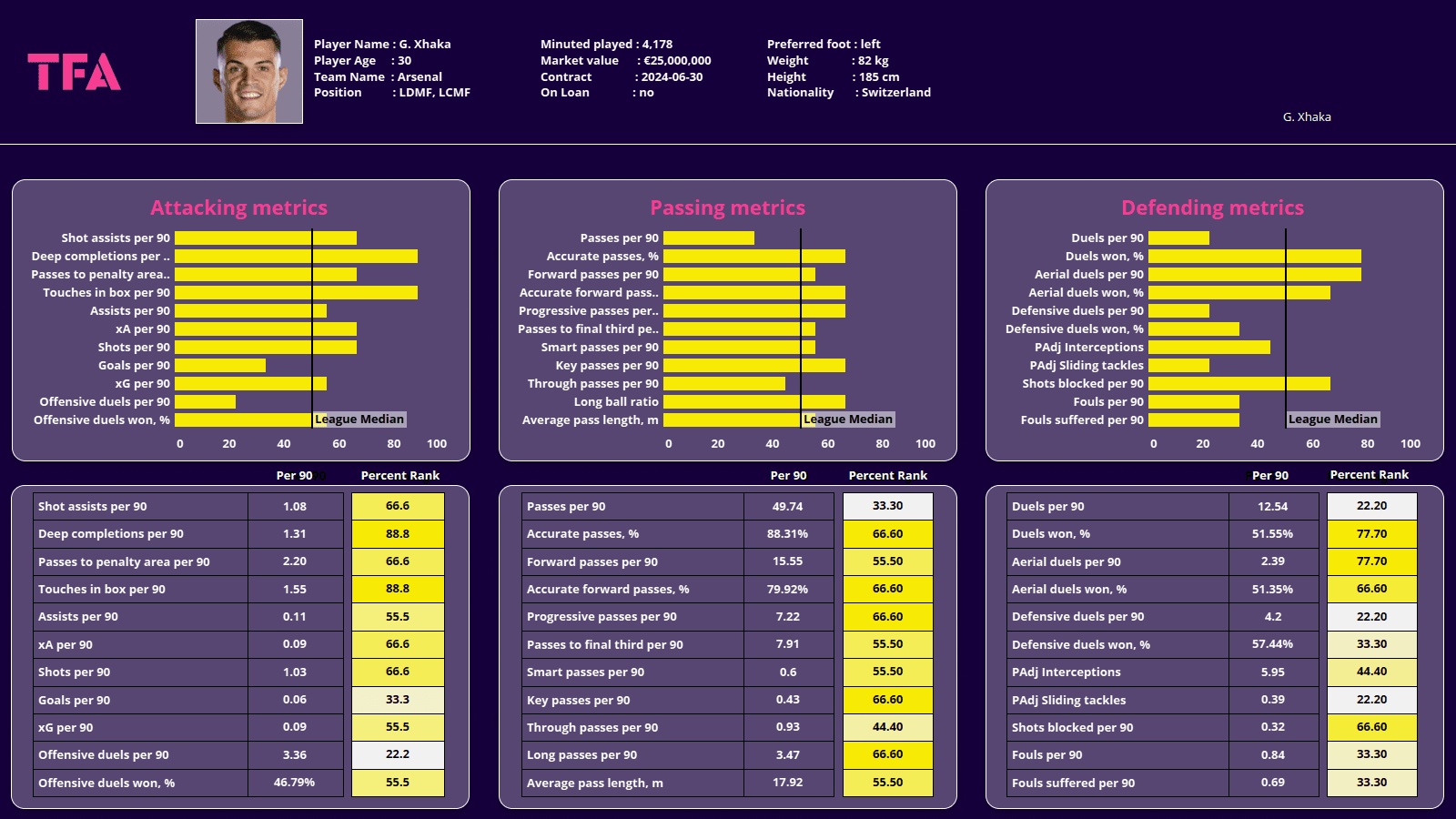
Overall, his positives completely outweigh his certain negatives and the stats show why Xhaka is probably the best Swiss player going into the tournament. Switzerland would be expecting him to be at his best for them to qualify and make it into the knockout stages.
Tournament prediction
With Brazil in their group, Switzerland would be the second favourite ahead of Cameroon and Serbia to qualify from their group into the next stage. Unlike last time, where they were knocked very early in the Round of 16, they would be hoping to reach the quarterfinals stage. It would be then very competitive and difficult for them in the quarter-finals as they will start facing favourites like France, Portugal, Germany, etc in these phases. So, with the team that they have a final 16-exit at best would be our predicted outcome.

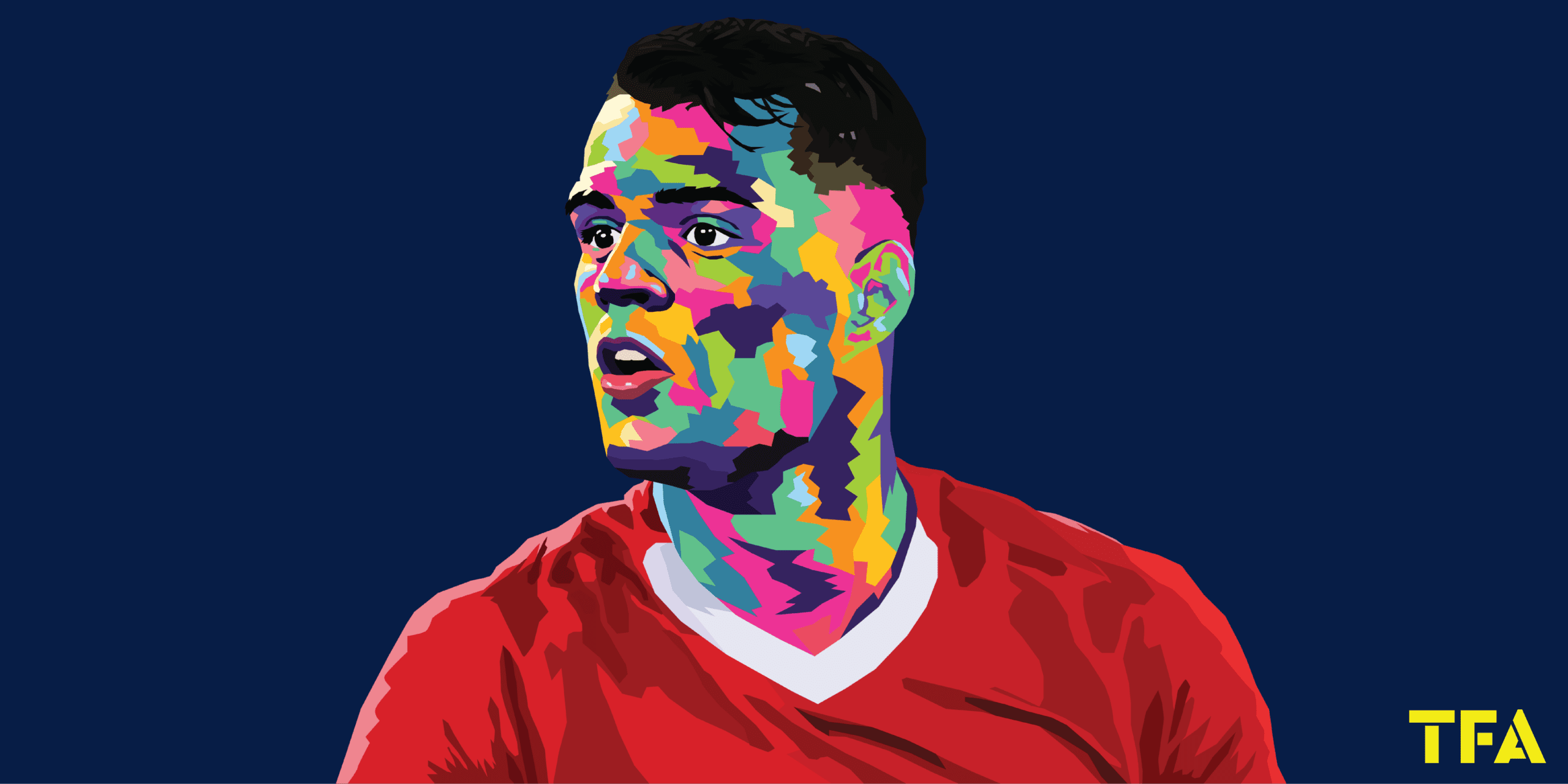



Comments